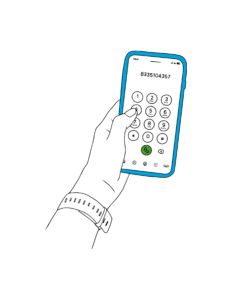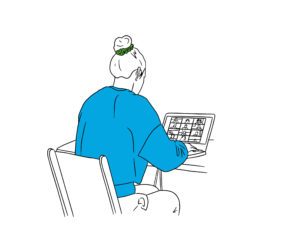TELEHEALTH CARE AND BRIGHTVIEW VIRTUAL
RECOVERY HAS NEVER BEEN MORE ACCESSIBLE
These days, providing reliable, easy-to-use telehealth care is the price of admission for medical and clinical providers.
Patients seeking help for addiction can now use telehealth to compliment their in-person care. Qualifying patients can engage with an effective all-online program called BrightView Virtual.
At BrightView, we work hard to ensure that patients can access the right care for their needs as fast and as conveniently as possible. We leverage telehealth care in a variety of forms, including medical appointments, counseling sessions, group therapy, case management, and peer recovery support.
ABOUT TELEHEALTH CARE AT BRIGHTVIEW
Most patients at BrightView will engage with telehealth at some level during their treatment program. Group therapy, one-to-one counseling, case management, peer support, and medical assessments can all be done using a computer or smart device.
Telehealth care can be used for patients to engage with tailored clinical programs (ex. Participation in LGBTQA+ groups or our New Moms groups), specialty medical care (ex. Provider with experience in OB/GYN and addiction medicine) or simply to help patients connect with peer support or case management services quickly.
ABOUT BRIGHTVIEW VIRTUAL
For qualifying patients, a comprehensive addiction treatment program is available entirely online through BrightView Virtual.
BrightView Virtual uses medication (MAT), group therapy, one-to-one counseling, and social services. This evidence-based care model is proven to help patients to heal mentally, emotionally, and physically from anywhere with reliable internet.
WHAT DO I NEED TO SUCCEED IN BRIGHTVIEW VIRTUAL?
To enroll in BrightView Virtual, patients will need access to a PC, laptop, tablet, or smartphone with a front-facing camera and microphone. They will also need a reliable internet connection through wi-fi or mobile data, and they will need Chrome, Safari, or Firefox downloaded (some programs are not supported on Internet Explorer). Patients will also need a private area where they can interact with medical and clinical providers without being overheard. Please note that a safe storage area for medications and toxicology supplies is also important.
HOW DO I ENROLL IN BRIGHTVIEW VIRTUAL?
STEP 1: CALL US AT 7402008876
Call 740.200.8876 to see if you or someone you are referring are eligible for a Virtual Induction. Our patient access specialists are helpful, compassionate, and willing to go the extra mile to answer any questions you might have about our services.
STEP 2: COMPLETE THE NECESSARY PAPERWORK ONLINE
The patient will need to complete a Virtual Induction Packet to get started. If you are referring a patient and will require reporting on their care, please have them complete a release of information form.
STEP 3: COMPLETE A VIRTUAL ASSESSMENT
Our care team will perform a medical and clinical assessment via a two-way video conferencing platform on a computer or smart device. If indicated, a medical provider will call in a prescription for medication to a local pharmacy of the patient’s choice.
STEP 4: ONGOING TREATMENT
The patient will meet virtually with their clinical team for counseling sessions and virtual group therapy. Ongoing treatment and support are provided at a level that addresses the patient’s acuity and goals.
FREQUENTLY ASKED QUESTIONS
What if I get disconnected from my provider or experience technical difficulties during my visit?
If you experience technical difficulties with sound or video, a member of our team may ask you to exit the video chat so they can re-start the session. If you accidentally exit the chat or virtual exam room before all your appointments are complete, please re-click the link from the text or email you received to re-enter the Backline chat.
What side effects may occur with Buprenorphine?
Side effects include constipation or sedation. Be careful when operating a vehicle after taking buprenorphine. Let your provider know if you experience any change in bowel movements. Other side effects such as headaches, nausea and vomiting are possible but less likely to occur. Abruptly stopping the medication will lead to signs and symptoms of withdrawal (nausea, vomiting, chills, anxiety, etc.). It is important to continue the medication as prescribed and work with your provider regarding any dose changes.
Buprenorphine can cause life threatening respiratory depression and sedation if it is taken with other sedatives. Other sedatives include, but are not limited to: alcohol, benzodiazepines, sleeping medications, etc. Attempts to override the buprenorphine by taking more opioids could result in an opioid overdose. Some other medications may affect the levels of buprenorphine in your body. In general, it is important to discuss any new medication or change with your buprenorphine prescriber. Antibiotics, antifungals, and antiviral medications especially should be discussed with your provider.
How should I store my Buprenorphine or other prescribed medication?
Even a small amount of buprenorphine can be extremely dangerous, especially to a child. Always keep these medicines stored in the original container. Always keep these medicines out of sight and out of the reach of children in a locked box or cabinet. Call Poison Control right away at 1-800-222-1222 if someone has ingested these medicines. Call Poison Control to find out the safest way to dispose of these medicines.
Is Buprenorphine treatment trading one addiction for another?
No. With successful buprenorphine treatment the compulsive behavior, the loss of control, the constant cravings, and all of the other hallmarks of addiction dissipate. When all signs and symptoms of the disease of addiction dissipate, we call that remission—not switching addictions. The key to understanding this is knowing the difference between physical dependence and addiction. Buprenorphine will maintain some of the pre-existing physical dependence but that is easily managed medically. Physical dependence, unlike addiction, is not a dangerous medical condition that requires treatment. Addiction is damaging and life-threatening, while physical dependence is an inconvenience and is normal physiology for anyone taking large doses of opioids for an extended period of time. It is essential to understand the definition of addiction and how it differs from physical dependence or tolerance.
ADDICTION MEDICINE NEWS
Enter your email address to follow BrightView and receive updates about addiction treatment news via email.
OHIO
Locations
- Akron
- Ashtabula
- Batavia
- Canton
- Dayton
- Chillicothe
- Cincinnati
- Colerain
- Columbus East
- Columbus West
- Dayton
- Dover
- Elyria
- Fairfield
- Georgetown
- Kent
- Lancaster
- Lima
- Mansfield
- Marietta
- Marion
- Mason
- Middletown
- Newark (North)
- Newark
- Parma
- Piqua
- Portsmouth
- Reynoldsburg
- Sandusky
- Springfield
- Toledo
- Warren
- Willoughby
- Wilmington
- Youngstown
- Zanesville


